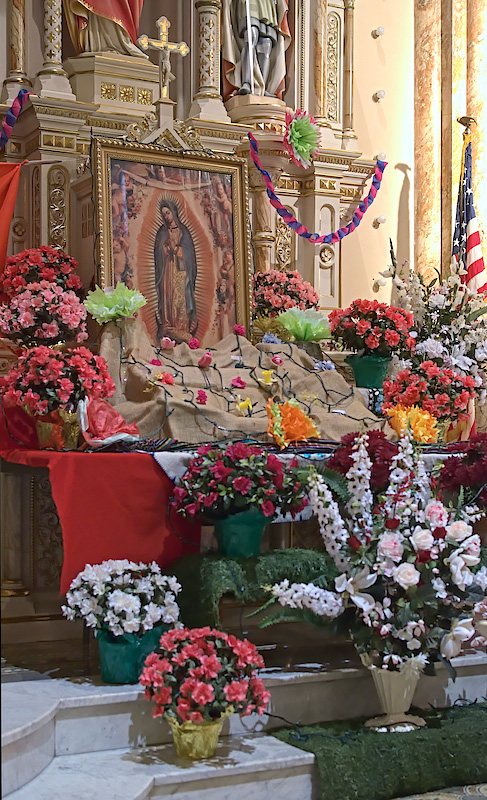A MOTHER'S LAMENT over the slaughter of the innocent children by King Herod, for the feast day of the Holy Innocents:
Saturday, December 28, 2013
Coventry Carol
Thursday, December 12, 2013
Friday, November 29, 2013
Photos of Saint John the Evangelist Church, in Paducah, Kentucky
HERE ARE PHOTOS of Saint John the Evangelist Church, located in the historic town of Paducah, in the western part of the Commonwealth of Kentucky. It is about 180 highway miles southeast of downtown Saint Louis, and is a part of the Diocese of Owensboro.
The town of Paducah was named by famed explorer William Clark after the Comanche tribe, then known by some other tribes as the Padoucas.
I visited Paducah a while back because I was accompanying a lady friend who wanted see the National Quilt Museum, located in that town near the riverfront. I will give a few thoughts on the museum on another posting.
We arrived at sunset, and though we had a long drive back to Saint Louis, I wanted to take some good photos of this church:
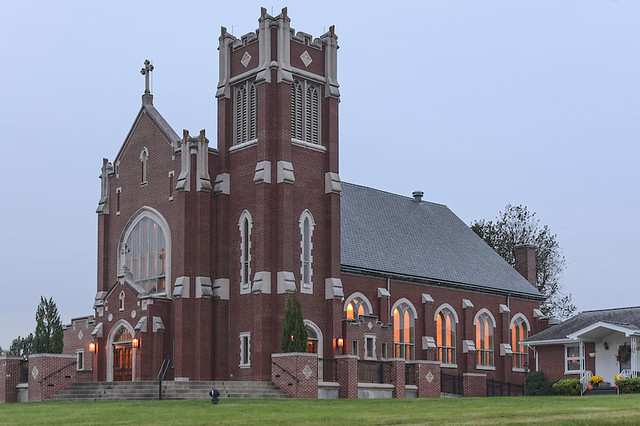
The church is Gothic revival, in the manner of the late Gothic style.
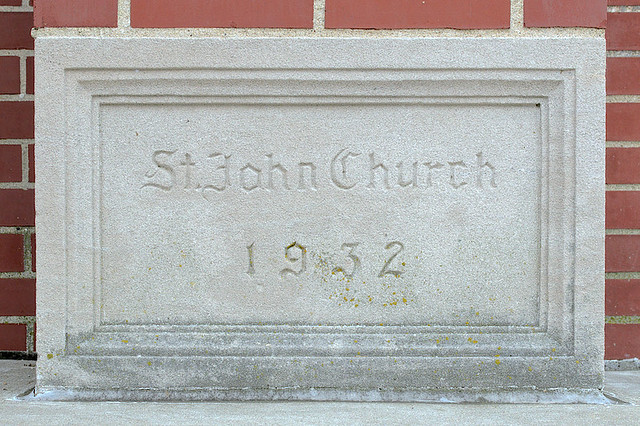
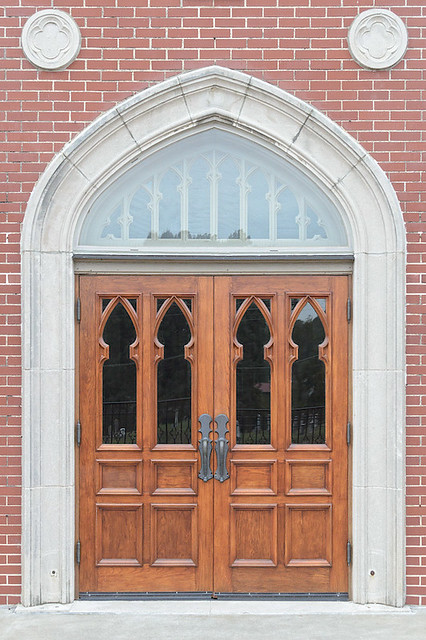
The Dioecesis Owensburgensis was erected in 1937 from land taken from the Diocese of Louisville, and its current ordinary is Bishop William Francis Medley. This diocese, along with the dioceses of Covington, Knoxville, Lexington, Memphis, and Nashville, is suffragan to the Archdiocese of Louisville — originally the Diocese of Bardstown. This is the Church in Tennessee and Kentucky.

The nave of the church. Musicians are seen here preparing for Holy Mass.
From a history found on the church’s website:
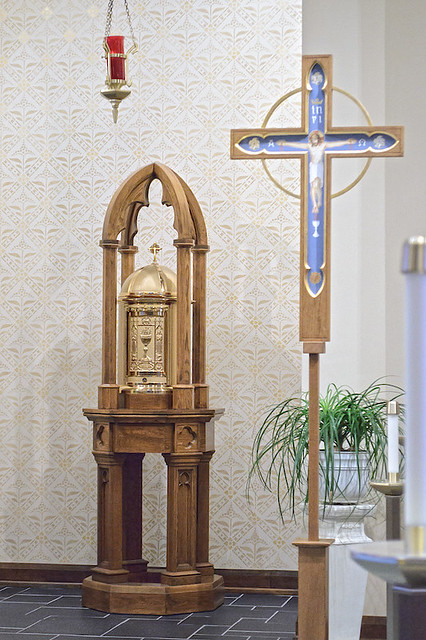
The tabernacle and crucifix.
The history continues:
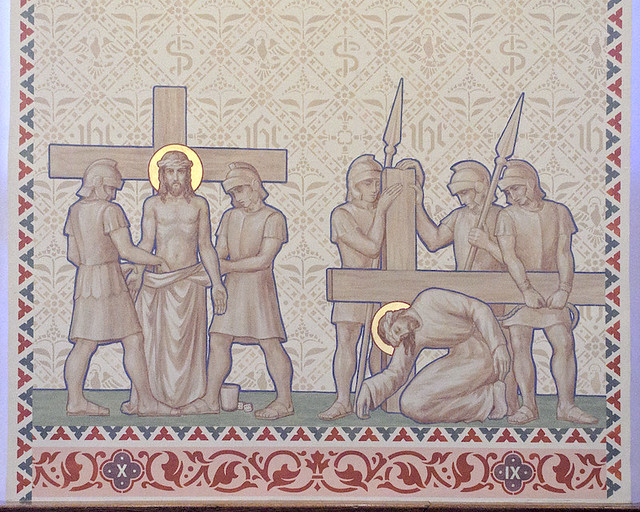
Two of the Stations of the Cross — Jesus Falls the Third Time on the right, and Jesus is Stripped of His Garments on the left.
Ornamentation in architecture has been largely a lost art since the popularization of the ideas found in Adolf Loos’ lecture of 1910, Ornament and Crime, where he claimed that the ornamentation of architecture was like the tattoos on degenerates and criminals of his age. But there is little that we need to take from the polemic of that “grumpy Marxist” other than his observation that ornament can make a building obsolete faster, as it goes out of style. True — what’s “up-to-date” is soon out-of-date — but if good taste and classic styling is used, then we needn’t worry about something going out of style any time soon — for it already is of the ages. This is the aim of the new American school of ecclesiastical architecture, coming out of the University of Notre Dame.
I particularly like the simple yet symbolic ornament depicted in this photo, behind the figures of Christ. We see a serpent and a sword, symbolizing the two failed martyrdoms of Saint John, who unlike all of the other Apostles lived to a ripe old age. We also see St. John’s symbol of the eagle, the Greek monogram for Christ, ιηϲ, and some vegetative ornament.
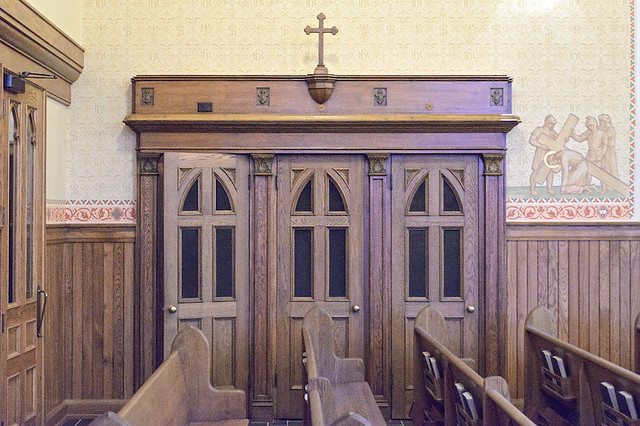
Confessional.
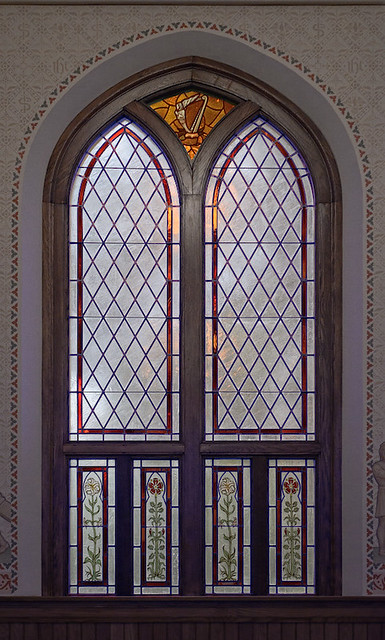
The blue light of dusk, mixed with the fluorescent lighting inside of the church confused my camera, as we can see in the photo of the nave above. Here I color-corrected this window to make it appear more natural. The windows here are largely simple — here we see some floral ornament along with a harp — a symbol of King David the Psalmist.
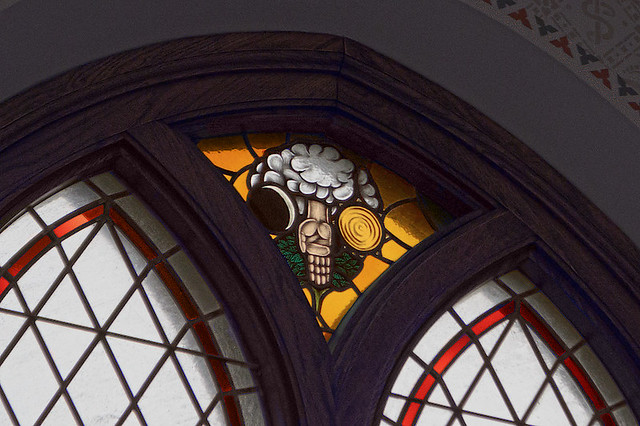
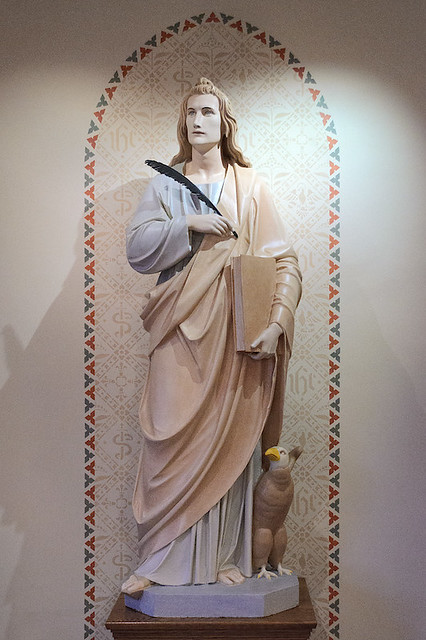
A sculpture of Saint John in the narthex. We see him here with a quill and book, symbolizing the Gospel he wrote; said Gospel is so full of soaring theology that the Fathers of the Church assigned him the symbol of the eagle. Artistic depictions of several of the Saints of the ancient church have distinctive facial features, which can be traced back to the earliest of sources. John is here depicted as a beardless youth.
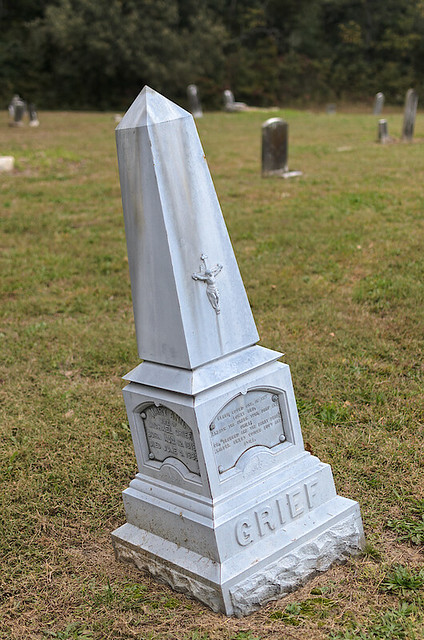
Grief.
Two cemeteries are found outside of the church — this is from the older one, located across the street from the church.

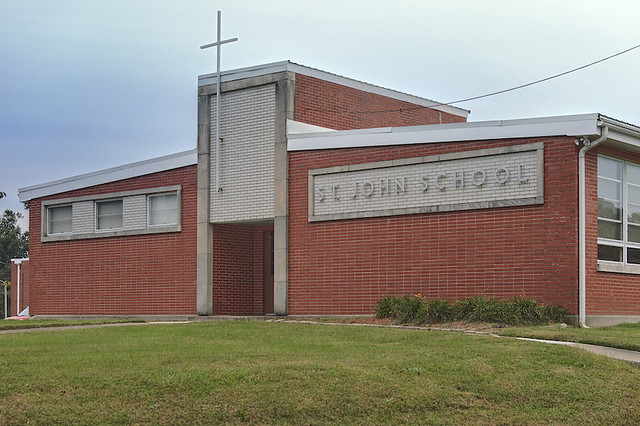
The school.
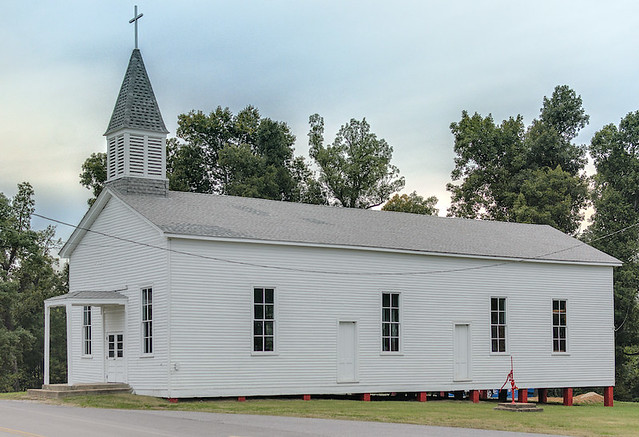
The old frame church?
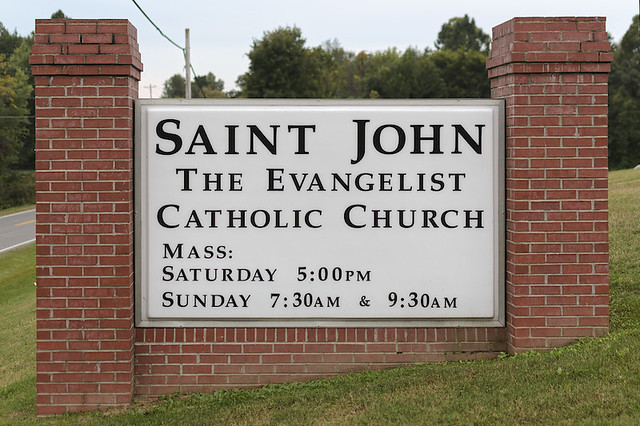
The town of Paducah was named by famed explorer William Clark after the Comanche tribe, then known by some other tribes as the Padoucas.
I visited Paducah a while back because I was accompanying a lady friend who wanted see the National Quilt Museum, located in that town near the riverfront. I will give a few thoughts on the museum on another posting.
We arrived at sunset, and though we had a long drive back to Saint Louis, I wanted to take some good photos of this church:

The church is Gothic revival, in the manner of the late Gothic style.

St. John Church
1932
1932

The Dioecesis Owensburgensis was erected in 1937 from land taken from the Diocese of Louisville, and its current ordinary is Bishop William Francis Medley. This diocese, along with the dioceses of Covington, Knoxville, Lexington, Memphis, and Nashville, is suffragan to the Archdiocese of Louisville — originally the Diocese of Bardstown. This is the Church in Tennessee and Kentucky.

The nave of the church. Musicians are seen here preparing for Holy Mass.
From a history found on the church’s website:
St. John the Evangelist Catholic Church was founded in 1839 by a group of German Catholic immigrants who had settled in Western Kentucky several years earlier. These first parishioners were visited by Fr. Elisha J. Durbin who had been assigned the missions throughout the territory that today make up the diocese of Owensboro. Fr. Durbin’s headquarters was at Sacred Heart Church, in Union County, Kentucky and his missionary duties took him to several surrounding states. Accordingly, the privilege of Mass and the Sacraments was not available to the people of the St. John community on a regular basis for some time.
The first church, a log building, was raised by the parishioners under the direction of Fr. Durbin around 1849. The log church burned and was replaced by a larger frame structure in 1869 under the direction of Fr. Peter Haeseley. The frame church was used for sixty-three years, until the construction of the present church building in 1932-1933 during the pastorate of Fr. Paul Barrett. All three churches were located on the same site.

The tabernacle and crucifix.
The history continues:
Few changes occurred to our church since 1933. The main update occurred in the 1960’s following Vatican II which included the removal of the tall canopy and the high altar.
In 2003, with guidance from Fr. Bruce McCarty, the parish undertook a general renovation project consisting of substantial exterior and interior repairs and a general updating of building systems. It also included the construction of an addition to include handicapped accessible restrooms, a reconciliation room and sacristy. A concerted effort was made to maintain and enhance the architectural and artistic integrity of the structure while bringing it in line with the liturgical needs of a 21st century parish.
On February 19, 2006, a Mass of Thanksgiving and Dedication of Altar was held with The Most Reverend John J. McRaith, Bishop of Owensboro, as celebrant.

Two of the Stations of the Cross — Jesus Falls the Third Time on the right, and Jesus is Stripped of His Garments on the left.
Ornamentation in architecture has been largely a lost art since the popularization of the ideas found in Adolf Loos’ lecture of 1910, Ornament and Crime, where he claimed that the ornamentation of architecture was like the tattoos on degenerates and criminals of his age. But there is little that we need to take from the polemic of that “grumpy Marxist” other than his observation that ornament can make a building obsolete faster, as it goes out of style. True — what’s “up-to-date” is soon out-of-date — but if good taste and classic styling is used, then we needn’t worry about something going out of style any time soon — for it already is of the ages. This is the aim of the new American school of ecclesiastical architecture, coming out of the University of Notre Dame.
I particularly like the simple yet symbolic ornament depicted in this photo, behind the figures of Christ. We see a serpent and a sword, symbolizing the two failed martyrdoms of Saint John, who unlike all of the other Apostles lived to a ripe old age. We also see St. John’s symbol of the eagle, the Greek monogram for Christ, ιηϲ, and some vegetative ornament.

Confessional.

The blue light of dusk, mixed with the fluorescent lighting inside of the church confused my camera, as we can see in the photo of the nave above. Here I color-corrected this window to make it appear more natural. The windows here are largely simple — here we see some floral ornament along with a harp — a symbol of King David the Psalmist.


A sculpture of Saint John in the narthex. We see him here with a quill and book, symbolizing the Gospel he wrote; said Gospel is so full of soaring theology that the Fathers of the Church assigned him the symbol of the eagle. Artistic depictions of several of the Saints of the ancient church have distinctive facial features, which can be traced back to the earliest of sources. John is here depicted as a beardless youth.

Grief.
Two cemeteries are found outside of the church — this is from the older one, located across the street from the church.

ALL YE GOOD PEOPLE
AS YOU PASS BY,
AS YOU ARE NOW
SO WAS I,
AS I AM NOW
SO WILL YOU BE,
REMEMBER MAN
AND PRAY FOR ME.
R.I.P.
AS YOU PASS BY,
AS YOU ARE NOW
SO WAS I,
AS I AM NOW
SO WILL YOU BE,
REMEMBER MAN
AND PRAY FOR ME.
R.I.P.

The school.

The old frame church?


Friday, November 22, 2013
The Allegory of Love
FIFTY YEARS AGO TODAY, there passed one of the greats of the 20th century. But Clive Staples Lewis’ death went largely unnoticed, lost in the traumatic events of the day. Lewis was an apologist, novelist, popular writer, and essayist, beloved of Christians of all churches, denominations, and sects; but he was also an accomplished scholar.
Love and marriage are horribly confused, conflated, and misunderstood in our current age, which does not understand the forms and purposes of these things — or rather, our age doesn’t seem to understand the form and purpose of anything. It was on the topics of love and marriage that C.S. Lewis gained his academic fame, in his book The Allegory of Love: A Study in Medieval Tradition, dating from 1936. It was this book that showed that the Medieval literature on love was worthy of serious academic study: and it remains the starting point of much of contemporary scholarship.
Marriage is a human institution, closely tied to the law and specific human circumstances — but it is rooted in human nature — while love is universal. How these two things interrelate is explored in great and even shocking depth in the Medieval literature. It is said that one flaw in Lewis’ book is that he treats love as a literary phenomenon, and not as something real, which he later corrected in his more popular book The Four Loves. Another flaw in his book is his incorporation of modern literary theories, whose frameworks don’t quite fit the data, and today we likewise have ideological — Marxist, Darwinist, Postmodernist, or Calvinist — readings of the literature which might explain one or another narrow aspect of love fairly well, while failing to consider the entire whole in a satisfactory manner.
Studying Medieval love literature can be hazardous: its allegorical method can be overlooked, its explicit depictions may be shocking, its unromantic portrayals of romantic love can be disturbing, and its essential Catholicity is rejected by contemporary conservatives and liberals alike. But Lewis was onto something: understanding love in all of its aspects is of great value to us today, and in every age.
Thursday, November 21, 2013
Newsletter from the Oratory
|
Thursday, November 14, 2013
“Christmas in St. Louis”
CHRISTMAS IN ST. LOUIS is a new book from Reedy Press, with text by Dr. John Oldani, and photography by me!

I can autograph and send you a copy: click the Paypal button below.
For alternative payment options, please send me a message or call — my contact information is off the right on the sidebar.
Both Dr. Oldani and myself are available for speaking engagements and interviews. Keep up-to-date by liking the book’s page on Facebook.
NEW BOOK SHOWCASES THE SPLENDOR OF ST LOUIS
CHRISTMASES PAST AND PRESENT
ST. LOUIS, MO — Christmas in St. Louis is a special time in a special place. As you’ll discover in the pages of this festive pictorial book, the Gateway City goes all-out to celebrate the season. Folklorist and professor Dr. John L. Oldani and photographer Mark S. Abeln have created a living album of Christmas wonders in Christmas in St. Louis: Traditions, Displays, and Celebrations (Reedy Press). Learn how traditions developed and shifted throughout the decades, from the iconic and nostalgic downtown department store windows to the millions of light displays all over the metro region. Along the way, the book captures the international flavor of Christmas in Main Street St. Charles, the remarkable residential displays of St. Louis Hills, the one million lights of Tilles Park, the dazzling, mile-and-a-half drive at Our Lady of the Snows, and myriad other traditions that have come to define a St. Louis Christmas.
Dr. John L. Oldani, a St. Louis native, has been a professor of American Studies and folklore at American and international universities. He has authored five books on American folklore. Mark S. Abeln has been taking photography seriously since 2005. His work has appeared in numerous books on St. Louis.
Christmas in St. Louis is available wherever books are sold.
Christmas in St. Louis: Traditions, Displays, and Celebrations
by John Oldani, photography by Mark S. Abeln, ISBN: 9781935806530, hardcover 11 x 8.5, 144 pages, $32.95
Contact: Don Korte (314) 644-3400, dkorte@reedypress.com
Friday, November 08, 2013
Photos of Saint Anthony Church, in Glennon, Missouri
HERE ARE PHOTOS of Saint Anthony Church, located in the southeastern Missouri town of Glennon, in Bollinger County. The church is a mission of the Diocese of Springfield-Cape Girardeau, and is 140 highway miles south of downtown Saint Louis.
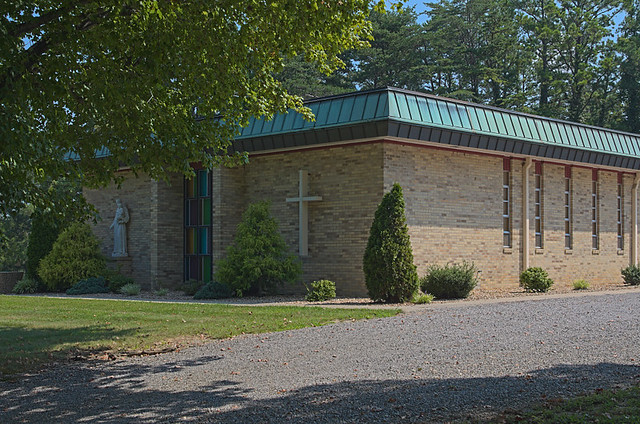
The current church, dating from 1969, is low and built of brick. Perhaps we can discover a possible reason for this design in a photo below…
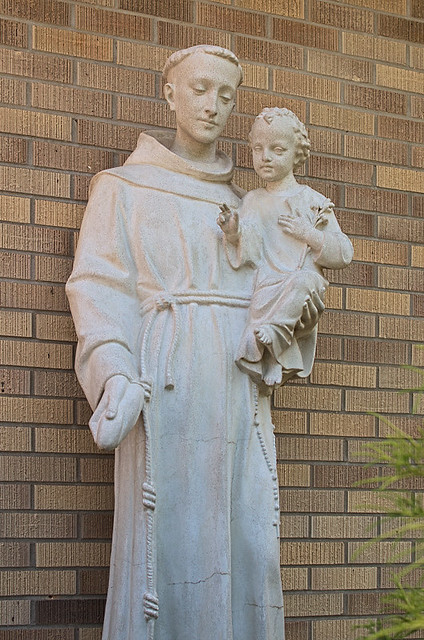
Statue of Saint Anthony of Padua (15 August 1195 – 13 June 1231), a Portuguese priest of the Order of Friars Minor (the Franciscans), depicted here holding the Christ Child in one hand and bread in the other. According to the Catholic Encyclopedia:
Despite being Catholic for over 10 years, I still have very much of a Protestant sensibility. Saint Anthony is commonly prayed to for finding lost items; while I do not reject the practice of asking for the intercession of Saints in all good things (see Rev. 5:8), I still have a lingering fear that this particular lowly task might be beneath such a great Saint known for his preaching. Now, I had spent days searching for a tax receipt, and in my great frustration, I finally overcame my prejudice, and offered up to Saint Anthony a quick prayer for intercession. Within seconds, I found the receipt in the first place I looked. Deo gratias.

This plaque is found outside of the front door:
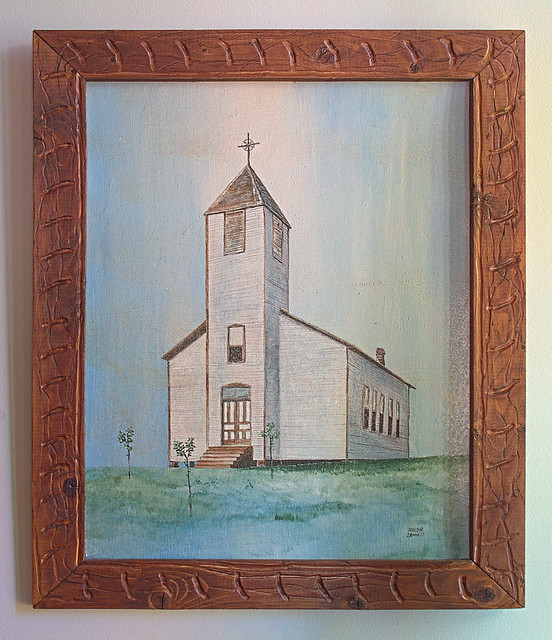
A painting of the first church, found in the narthex. This design is typical of many country churches in this region.
The community of Glennon was named after Archbishop John Joseph Glennon, and was originally in the Archdiocese of Saint Louis. Another Catholic settlement in Missouri is named Glennonville, after the same Cardinal.
If all the polar icecaps in the world were to melt, Glennon would be oceanfront property. It sits on the very edge of the Ozark plateau, right at the head of the vast, low-lying Mississippi Alluvial Plain, which extends hundreds of miles southward to the Gulf of Mexico.
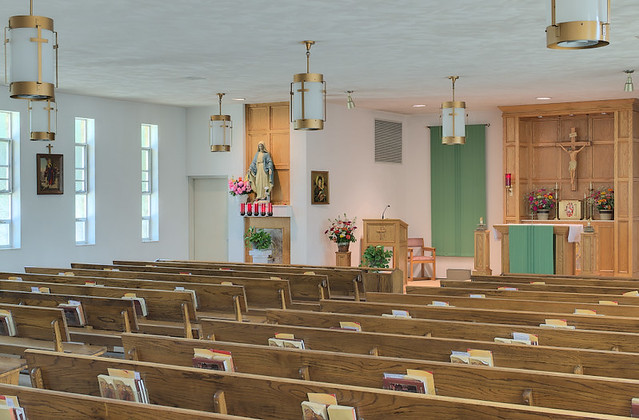
This is a small church, typical of its time; I like the decoration.
Normally, I take photos of the nave along the central aisle, but the lighting fixtures above the aisle got in the way of the Crucifix, leading me to take a photo at an angle. Perhaps I neglected to photograph Saint Joseph here?
These photos are best viewed at larger resolution, which you can see by clicking on the photos.

The Crucifix, Tabernacle, and Altar, the cause of our salvation.

Devotion to the Blessed Virgin. Aren’t the flowers good?

Baptismal font and another statue of Saint Anthony with the Christ Child.
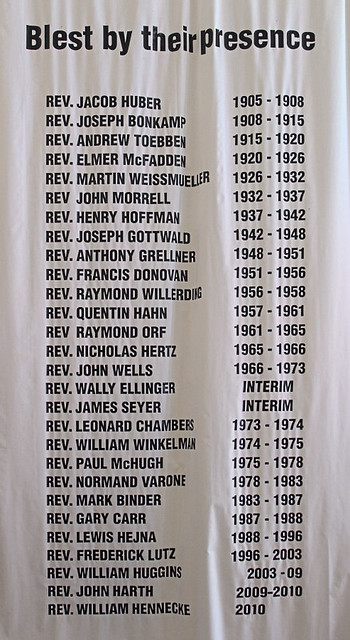
A list of the priests of the parish hangs near the entrance. Many German and Irish surnames here.
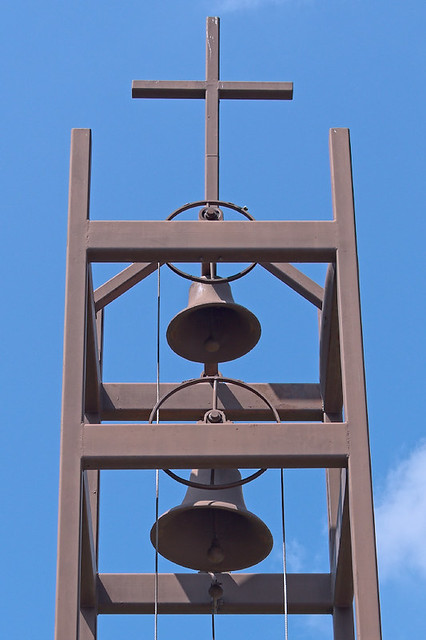
A view of the church’s bell tower.
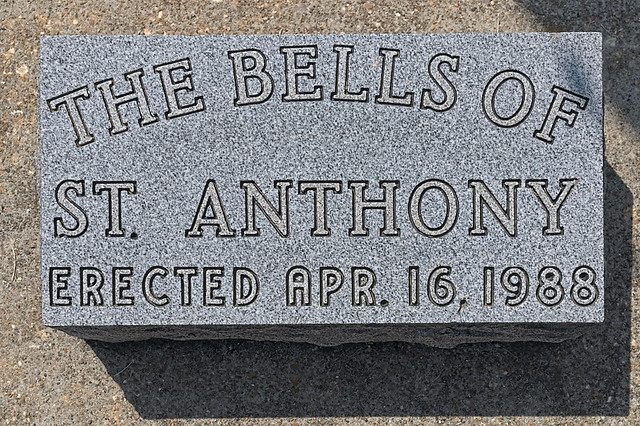
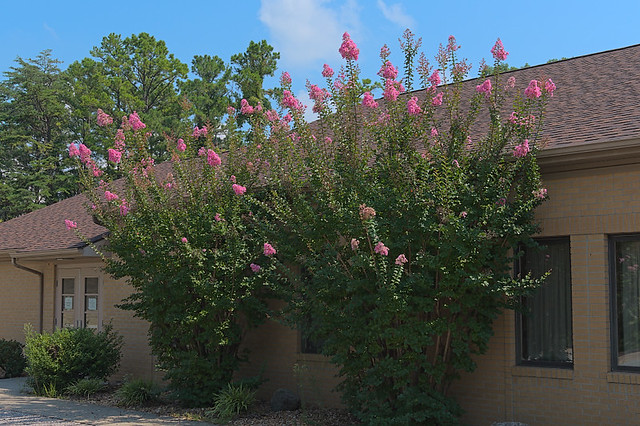
Tall blooming bushes by the church hall. I took these photos in August.
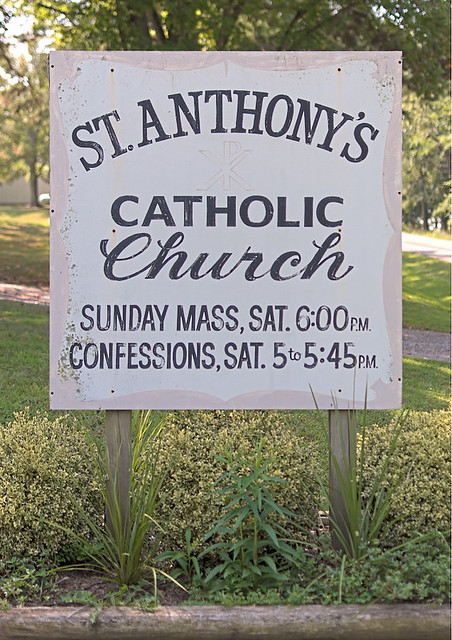
Click here for a map of the church.

The current church, dating from 1969, is low and built of brick. Perhaps we can discover a possible reason for this design in a photo below…

Statue of Saint Anthony of Padua (15 August 1195 – 13 June 1231), a Portuguese priest of the Order of Friars Minor (the Franciscans), depicted here holding the Christ Child in one hand and bread in the other. According to the Catholic Encyclopedia:
“He possessed in an eminent degree all the good qualities that characterize an eloquent preacher: a loud and clear voice, a winning countenance, wonderful memory, and profound learning, to which were added from on high the spirit of prophecy and an extraordinary gift of miracles. With the zeal of an apostle he undertook to reform the morality of his time by combating in an especial manner the vices of luxury, avarice, and tyranny. The fruit of his sermons was, therefore, as admirable as his eloquence itself. No less fervent was he in the extinction of heresy, notably that of the Cathares and the Patarines, which infested the centre and north of Italy…Anthony is the second-fastest canonized Saint in history and is a Doctor of the Church.
“The zeal with which St. Anthony fought against heresy, and the great and numerous conversions he made rendered him worthy of the glorious title of Malleus hereticorum (Hammer of the Heretics). Though his preaching was always seasoned with the salt of discretion, nevertheless he spoke openly to all, to the rich as to the poor, to the people as well as those in authority. In a synod at Bourges in the presence of many prelates, he reproved the Archbishop, Simon de Sully, so severely, that he induced him to sincere amendment.”
Despite being Catholic for over 10 years, I still have very much of a Protestant sensibility. Saint Anthony is commonly prayed to for finding lost items; while I do not reject the practice of asking for the intercession of Saints in all good things (see Rev. 5:8), I still have a lingering fear that this particular lowly task might be beneath such a great Saint known for his preaching. Now, I had spent days searching for a tax receipt, and in my great frustration, I finally overcame my prejudice, and offered up to Saint Anthony a quick prayer for intercession. Within seconds, I found the receipt in the first place I looked. Deo gratias.

This plaque is found outside of the front door:
ST. ANTHONY’S CHURCHA history of the devastating 1917 tornado can be found here.
WAS BUILT IN 1905
DESTROYED BY TORNADO IN 1917
ST. ANTHONY’S CHURCH
WAS BUILT IN 1917
DESTROYED BY FIRE IN 1969
ST. ANTHONY’S CHURCH
WAS BUILT IN 1969
AND DEDICATED AUG. 1970

A painting of the first church, found in the narthex. This design is typical of many country churches in this region.
The community of Glennon was named after Archbishop John Joseph Glennon, and was originally in the Archdiocese of Saint Louis. Another Catholic settlement in Missouri is named Glennonville, after the same Cardinal.
If all the polar icecaps in the world were to melt, Glennon would be oceanfront property. It sits on the very edge of the Ozark plateau, right at the head of the vast, low-lying Mississippi Alluvial Plain, which extends hundreds of miles southward to the Gulf of Mexico.

This is a small church, typical of its time; I like the decoration.
Normally, I take photos of the nave along the central aisle, but the lighting fixtures above the aisle got in the way of the Crucifix, leading me to take a photo at an angle. Perhaps I neglected to photograph Saint Joseph here?
These photos are best viewed at larger resolution, which you can see by clicking on the photos.

The Crucifix, Tabernacle, and Altar, the cause of our salvation.

Devotion to the Blessed Virgin. Aren’t the flowers good?

Baptismal font and another statue of Saint Anthony with the Christ Child.

A list of the priests of the parish hangs near the entrance. Many German and Irish surnames here.

A view of the church’s bell tower.

THE BELLS OF
ST. ANTHONY
ERECTED APR. 16, 1988

Tall blooming bushes by the church hall. I took these photos in August.

Click here for a map of the church.

Dawn Eden to Speak at SLU High
DAWN EDEN, known for her books The Thrill of the Chaste and My Peace I Give You: Healing Sexual Wounds with the Help of the Saints, will be speaking at the St. Louis University High School, on Sunday, November 10th, 2013 at 1:30 p.m.
Her talk will be followed by Holy Mass offered by Fr. Augustine Wetta, O.S.B.

This talk is intended for parents.
A recent talk by Miss Eden, “What the Saints Can Teach Us About Purification of Memory”, can be found here.
Address:
4970 Oakland Avenue
Saint Louis, Missouri 63110

Location:
Saint Louis University High School
Friday, November 01, 2013
Newsletter from the Oratory
 SAINT FRANCIS DE SALES ORATORY EMAIL NEWSLETTER 2653 Ohio Avenue Saint Louis, Missouri 63118 www.institute-christ-king.org www.TraditionForTomorrow.com 314-771-3100 | ||
|
Thursday, October 31, 2013
The Piasa Bird
THIS TERRIFYING CREATURE is the Piasa Bird, painted on the river bluffs upstream from Alton, Illinois.

This is a loose, modern interpretation of original paintings mentioned by Fr. Jacques Marquette, S.J., who explored this area with Louis Joliet in 1673. From his journal:

This is a loose, modern interpretation of original paintings mentioned by Fr. Jacques Marquette, S.J., who explored this area with Louis Joliet in 1673. From his journal:
“While Skirting some rocks, which by Their height and Length inspired awe, We saw upon one of them two painted monsters which at first made Us afraid, and upon Which the boldest savages dare not Long rest their eyes. They are as large As a calf; they have Horns on their heads Like those of deer, a horrible look, red eyes, a beard Like a tiger’s, a face somewhat like a man’s, a body Covered with scales, and so Long A tail that it winds all around the Body, passing above the head and going back between the legs, ending in a Fish’s tail. Green, red, and black are the three Colors composing the Picture. Moreover, these 2 monsters are so well painted that we cannot believe that any savage is their author; for good painters in france would find it difficult to paint so well, — and, besides, they are so high up on the rock that it is difficult to reach that place Conveniently to paint them.”We are told that ‘piasa’ means man-eater. A legend of the Piasa bird was written by a classics professor from Alton, John Russell, in about 1836, which can be read in its entirety here:
“…Each morning and afternoon thereafter, the Piasa Bird came, shattering the peace of the village with its blood-chilling screams and the thunderous beat of its wings. More often than not, it returned to its lair with a victim.
“The Illini looked to their chief, Ouatoga, for a solution to this menace. Time and time again he had led them through the trials of famine, illness, and the threat of warlike tribes. But Ouatoga felt helpless before this danger and the years weighed heavily upon him. The beast seemed invulnerable. His body was covered with scales, like a coat-of-mail. The best efforts of Tera-hi-on-a-wa-ka, the arrow maker, and the tribe’s finest archers were to no avail.
“Then Ouatoga appealed to the Great Spirit. For nearly a full moon he prayed and fasted. Then in a dream he found the answer. The body of the Piasa Bird was not protected under the wings. After offering thanks to the Great Spirit, Ouatoga called the tribe together and devised a plan that could destroy the Piasa Bird…”
Thursday, October 24, 2013
A Canoe Trip on the Mingo River
LAST SATURDAY, I went on a canoe trip at the Mingo National Wildlife Refuge, in the southeastern part of the state of Missouri, near the town of Puxico.

Autumn is perhaps the prettiest time of year in this part of the world, narrowly beating out Spring due to typically dry weather. This was a cold day — not the best for canoeing, due to the risk of capsize — but a beautiful one. The lack of mosquitoes and deadly vipers during this time of year makes a fall visit even more appealing.
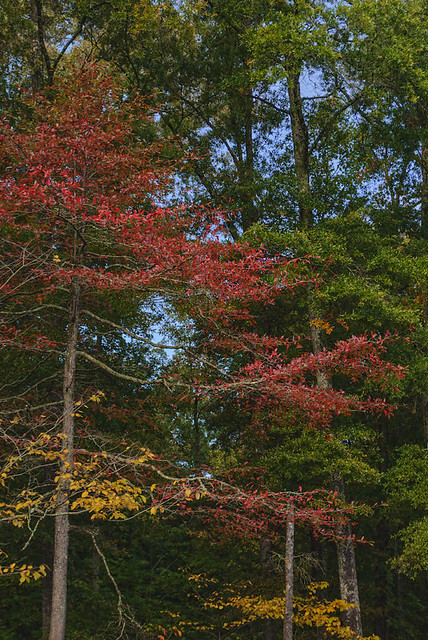
The Mingo River meanders through the Mingo swamp, which is a small remnant of a formerly much larger swamp that covered the lowlands near the Mississippi River, south of Cape Girardeau, Missouri.
Much of these lowlands were drained and logged a century or more ago, with the land now being used for crops. But flooding is always a concern here; nearly the entirety of nearby Mississippi County is sacrificed as a floodway when the waters get too high.
The land is flat and featureless, with only the nearby Crowley’s Ridge giving relief to the topography of the region. In the forest itself, it is quite easy to get lost, for all directions look the same, and the bends of waterways can trap the casual hiker.

Duckweed, which is perhaps the smallest of all flowering plants, covers a stretch of the gently flowing river. The sound of the canoe pushing through the duckweed is not unlike the sound of a sled in snow.

A common tree in these swamps is the Bald cypress (Taxodium distichum). While a relative of the evergreens, this cypress loses its leaves in the winter. The leaves turn a dull reddish-orange color in the Fall, as seen in these photos.

These cypresses have a distinctive wide base, as well as ‘knees’ that stick up out of the water around the base, as seen here. Some individual trees here are older than a thousand years. Cypress wood is valued because it does not rot when wet; in Europe, cypress and cedar (also found here) were valued for the construction of churches, as we find in the stave churches of Scandinavia. The First Jewish Temple of Solomon was constructed of these woods, imported from Lebanon.
Architecturally speaking, this is a much-neglected wood. And as it happens, cypress swamps are the most productive of all forestlands. As land can be inexpensive here, it would seem to be reasonably easy to reestablish larger cypress forests.
Tupelo trees, which also grow here in the water, have smoother, somewhat rounded bases.

These photos are best displayed on a dark background; click the photo to be taken to Flickr, where you can get a better view of them.
This is about the northernmost range of cypress, which is found throughout the Southeastern US. While it will grow farther north (many are planted in Forest Park, in Saint Louis), the tree does not reproduce well if it gets too cold.

Like the Nile delta in Egypt, the Mississippi River delta is vast, and relatively unknown to most Americans. Stretching for about 600 miles from southern Missouri, through Arkansas, Kentucky, Tennessee, and Mississippi, it ends in the swamplands of Louisiana at the Gulf of Mexico. While this region is heavily modified by humans, frequent flooding shows nature’s dominance.
The Mississippi River, which is placid and clear in its northernmost stretches, becomes deep, narrow, muddy, and swift, starting just north of Saint Louis at the river’s confluence with the Missouri River: this is also a dangerous stretch of river, where perhaps on average one steamboat wreck per mile can be uncovered, and many sunken modern barges can be see here in low water.
But after the confluence of the Ohio River — which forms the southern border of Illinois — the Mississippi becomes sluggish, laden with silt, and meandering, splitting off into innumerable islands, and bordered by vast swamps, even to this day. A major flood could cut off one part of a state and attach it to another, as we find in many places hereabouts, including one large part of Kentucky, located across the river from New Madrid, which is not connected to the rest of the state.
At about this point, Fr. Jacques Marquette, S.J., who explored this area for the King of France and the Church, in the year 1673, wrote:
“Here we Began to see Canes, or large reeds, which grow on the bank of the river; their color is a very pleasing green; all the nodes are marked by a Crown of Long, narrow, and pointed leaves. They are very high, and grow so thickly that The wild cattle have some difficulty in forcing their way through them."

Missouri is typically considered to be a midwestern state in culture, and central Missouri’s dialect is the standard for national journalism in the USA. But the southeastern part of the state shows its historic southern roots as accents and other artifacts of culture change quickly the farther south you travel.
It is in this region that developed the distinctive American style of music known as the Blues, which greatly influenced popular styles of music worldwide. Here we find both fertile soil and great poverty; mixed with Calvinist religion, we then have a culture and its music which is haunted by the Devil, in every impenetrable swamp and at every crossroad. Singing the Blues, they say, gives you the blues.

But this was a pleasant and beautiful day, helped by an expert guide and pleasant company.

Subscribe to:
Posts (Atom)

